Religion of the ’00s: A Summary of the Decade
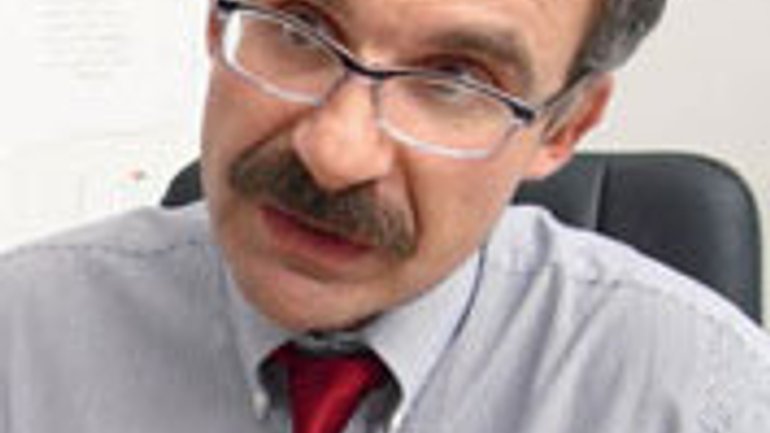
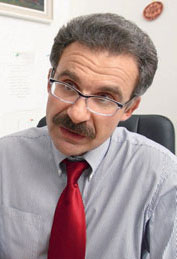 Among those who treated such prophecies seriously were also those not inclined to rejoice by their outcomes – the Canadian Security Intelligence Security Service (CSIS) and the United States Federal Bureau of Investigation (FBI). For nine months the latter intensively studied the possibility of religious groups resorting to violence on the eve of the new millennium. The results of the investigation were published in the report entitled “Project Megiddo,” in which the FBI concluded that there indeed may be some trouble from certain religious groups that link “doomsday” to the approaching new millennium, but that they are few in number, can be localized, and do not pose serious threats to national security. However, the passing of the beginning of the first millennium, the beginning of 2008, the birth of the 6,666,666,666th person, which according to “completely accurate prophecies” was to bring about the end of the world, again proved that no mortal knows the “day and time.”
Among those who treated such prophecies seriously were also those not inclined to rejoice by their outcomes – the Canadian Security Intelligence Security Service (CSIS) and the United States Federal Bureau of Investigation (FBI). For nine months the latter intensively studied the possibility of religious groups resorting to violence on the eve of the new millennium. The results of the investigation were published in the report entitled “Project Megiddo,” in which the FBI concluded that there indeed may be some trouble from certain religious groups that link “doomsday” to the approaching new millennium, but that they are few in number, can be localized, and do not pose serious threats to national security. However, the passing of the beginning of the first millennium, the beginning of 2008, the birth of the 6,666,666,666th person, which according to “completely accurate prophecies” was to bring about the end of the world, again proved that no mortal knows the “day and time.”
I.
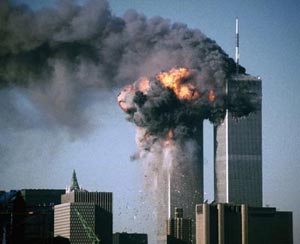 Nevertheless, the beginning of the millennium, century, and decade was truly frightful. On September 11, 2001, suicide bombers hijacked four planes, destroyed the twin towers, attacked the Pentagon, and killed more than three thousand people. All nineteen of the terrorists were Muslims. Osama bin Laden, the leader of Al-Qaida, which takes responsibility for the attack, says: “This war is fundamentally religious. The people of the East are Muslims. They sympathized with Muslims against the people of the West who are crusaders. Those who try to cover this crystal clear fact, which the whole world has admitted, are deceiving the Islamic nation. They are trying to deflect the attention of the Islamic nation from the truth of this conflict. Under no circumstances should we forget this enmity between us and the infidels. For, the enmity is based on creed.”
Nevertheless, the beginning of the millennium, century, and decade was truly frightful. On September 11, 2001, suicide bombers hijacked four planes, destroyed the twin towers, attacked the Pentagon, and killed more than three thousand people. All nineteen of the terrorists were Muslims. Osama bin Laden, the leader of Al-Qaida, which takes responsibility for the attack, says: “This war is fundamentally religious. The people of the East are Muslims. They sympathized with Muslims against the people of the West who are crusaders. Those who try to cover this crystal clear fact, which the whole world has admitted, are deceiving the Islamic nation. They are trying to deflect the attention of the Islamic nation from the truth of this conflict. Under no circumstances should we forget this enmity between us and the infidels. For, the enmity is based on creed.”
The 9/11 tragedy triggers a surge of religious sentiments – U.S. churches haven’t been so packed with faithful, who are praying with an increased fervor, in a long time. The newspaper “The Christian Science Monitor” (December 7, 2001) reported that for the first time in 50 years the vast majority of Americans recognize that religion has strengthened its foothold in the country.
Religious growth is accompanied by anti-Islamic sentiments. Franklin Graham, son of Billy Graham and very influential evangelist, said that “the God of Islam is not the same God. Islam is a very evil and wicked religion.” At the same time, CNN broadcasted a report from Gaza: Palestinians rejoice in the streets and applaud the terrorists. The next year Osama is the most popular name for newborns born to Arabs in Gaza and the West Bank.
In another corner of the world, in the Nigerian city Dzhos, Christian and Muslim youth barricade the streets. They stop cars: Muslims require passengers to declare Shahadah (“There is no God but Allah...”) and Christians the Gospel of John 3:16 (“For God so loved the world that He gave His only begotten Son...”). Those who refused or could not complete the task were killed.
Samuel Huntington’s book “The Clash of Civilizations and the Remaking of World Order” is being translated into more languages; its author writes an article “The Age of Muslim Wars”; a group of American intellectuals writes a letter “What Are We Fighting For,” arguing that a U.S. counterattack is a fair act of defense for the endangered values of the Western world.
A decade after the Cold War the world was plunged into a new global battle. This is a battle of religious-inspired terrorism, where the number of civilian casualties (still calculated very approximately) is significantly higher than the number of dead soldiers, and which is taking place not only in Iraq and Afghanistan but also in the London and Madrid subways, the streets of Jerusalem and Haifa, in Pakistan and India. “The global war on terror,” declared by President George W. Bush, has not made the world safer but rather less predictable and fearful.
People are becoming accustomed to taking off their shoes in airports, to the ubiquitous surveillance cameras, metal detectors, and barbed wire in the center of European capitals. The world has not heard such a militant religious rhetoric and such frequent references to religious symbols, texts, and images in a long time. In his addresses to the nation, George W. Bush mentions God and faith not only more frequently than did F. D. Roosevelt or Clinton but also more than Ronald Reagan.
In wars Muslims are often fighting on different sides of the front line and killing far more Muslims than any others. But there is a lot of evidence that the public considers the “global war on terror” as the confrontation of Islam and the West.
The arena of this conflict is two very different, even “antinomical,” continents – Africa and Europe.
II.
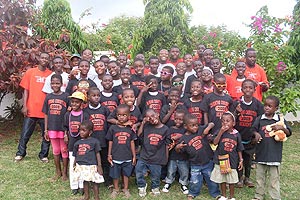 Over the past decade Christianity in Africa grew at a rate of 11 million people per year. This “Southern” Christianity – expansive and irreconcilable – openly and strongly competed with the equally intransigent and expansive Islam, which grew at a slightly slower rate (about 10 million people per year). Numerically the opposing forces seem almost equal (there is only a difference of 50 million in favor of Christians – insignificant considering Africa’s population is one billion).
Over the past decade Christianity in Africa grew at a rate of 11 million people per year. This “Southern” Christianity – expansive and irreconcilable – openly and strongly competed with the equally intransigent and expansive Islam, which grew at a slightly slower rate (about 10 million people per year). Numerically the opposing forces seem almost equal (there is only a difference of 50 million in favor of Christians – insignificant considering Africa’s population is one billion).
Christians and Muslims clashed in bloody military conflicts (like in Sudan or in Nigeria), competed for animists and totemists in Equatorial Africa, and relatively recently began massive campaigns to convert the most people. If previously it was believed that Islam was spreading by high childbirth rates, and Christianity by missionary activity (37 percent of people baptized in the early 2000s in Africa were adults), then now the Muslim mission is more offensive. In the past decade, Muslims have built mosques in places where their presence had not been significant until now, intensified Islamic propaganda in the media, opened a special place for Christians in Muslim schools, and in some places (such as Tanzania) encouraged girls from Christian families to marry Muslims by offering their fathers a bride price (a much larger price than what Muslims typically pay other Muslims). It seems the struggle for the soul of the continent, for which Christians and Muslims are fighting, has yet to reach its most acute phase.
III.
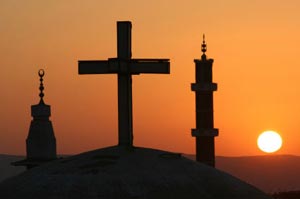 In its turn, Muslim presence in Western European cities over the past decade has become more distinct. Over the past century the number of Muslims in Western Europe has increased from some 53 thousand to 9.8 million. It is projected that Muslims will constitute 10–15 percent of the population in Western Europe in 2025 and 20–25 percent in 2050. In Denmark, where Muslims constitute less than 4 percent of the population, non-Danish mothers give birth to every tenth child; in Copenhagen every fourth. In Amsterdam, Rotterdam, and The Hague, among people under the age of twenty there are more immigrants than native Dutch. This means, among other things, increased cultural and socioeconomic differences between age groups: the chasm between the older, economically secured Germans, Belgians, French, and Austrians and the young, discontented Muslims of the suburbs is deepening. The adaptation programs for Muslims implemented in Western societies have not been very successful. Second, and even third, generation immigrants still feel like guests and, as a group, remain significantly poorer and more marginalized. The poor and disadvantaged are not ideologues of militant Islam, but they are most attracted to such ideologies; they were the ones who set off fireworks on September 11, 2001, in the suburbs of Berlin, who chanted "Bin Laden! Bin Laden!" at a France–Algeria soccer match, and who dressed as a suicide bomber at a London demonstration against the caricatures of Prophet Mohammed published in Denmark.
In its turn, Muslim presence in Western European cities over the past decade has become more distinct. Over the past century the number of Muslims in Western Europe has increased from some 53 thousand to 9.8 million. It is projected that Muslims will constitute 10–15 percent of the population in Western Europe in 2025 and 20–25 percent in 2050. In Denmark, where Muslims constitute less than 4 percent of the population, non-Danish mothers give birth to every tenth child; in Copenhagen every fourth. In Amsterdam, Rotterdam, and The Hague, among people under the age of twenty there are more immigrants than native Dutch. This means, among other things, increased cultural and socioeconomic differences between age groups: the chasm between the older, economically secured Germans, Belgians, French, and Austrians and the young, discontented Muslims of the suburbs is deepening. The adaptation programs for Muslims implemented in Western societies have not been very successful. Second, and even third, generation immigrants still feel like guests and, as a group, remain significantly poorer and more marginalized. The poor and disadvantaged are not ideologues of militant Islam, but they are most attracted to such ideologies; they were the ones who set off fireworks on September 11, 2001, in the suburbs of Berlin, who chanted "Bin Laden! Bin Laden!" at a France–Algeria soccer match, and who dressed as a suicide bomber at a London demonstration against the caricatures of Prophet Mohammed published in Denmark.
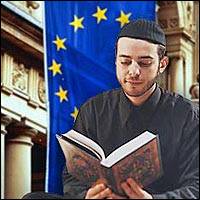 Finally, the Islamic presence in Europe is being visualized in the landscape of the ancient cities of the Old Continent, which many see as its transformation into "Euroarabia.” In Western Europe today there are about 7,000 mosques (2,400 of which are in Germany, 2,000 in France, and 1,500 in the UK). Some of these mosques are competing with Christian cathedrals, like the one opened in 2003 in Cordoba, Spain, which aims, according to its sponsors, to symbolize the Islamic revival in Europe. The resistance to the expansion of Islamic presence in Western Europe eventually spread to a Swiss referendum in 2009 (59 percent of participants called to ban the construction of minarets in the country), to a 2010 French law that banned the veil, and to the rejection of the Markazi mosque in London, which was to become the largest mosque in Europe and the largest sacred building in Britain.
Finally, the Islamic presence in Europe is being visualized in the landscape of the ancient cities of the Old Continent, which many see as its transformation into "Euroarabia.” In Western Europe today there are about 7,000 mosques (2,400 of which are in Germany, 2,000 in France, and 1,500 in the UK). Some of these mosques are competing with Christian cathedrals, like the one opened in 2003 in Cordoba, Spain, which aims, according to its sponsors, to symbolize the Islamic revival in Europe. The resistance to the expansion of Islamic presence in Western Europe eventually spread to a Swiss referendum in 2009 (59 percent of participants called to ban the construction of minarets in the country), to a 2010 French law that banned the veil, and to the rejection of the Markazi mosque in London, which was to become the largest mosque in Europe and the largest sacred building in Britain.
Serious research data from the 2000s among Muslims in European countries paints a colorful and controversial picture. It testifies to the existence of very large groups of Muslims who do not see any problem in being unconditionally committed to Islam and at the same time full-fledged members of Western societies. But many of them categorically reject Western values and see the world through the prism of the Muslim-Christian confrontation.
Moreover, unlike the passionate Christianity in Africa, Western European Christianity looks dejected. Traditional religious practices have decreased in the last decade (in some countries very substantially), the parish civilization has ceased to exist, the church has become vacant, the number of new priests has dramatically fallen, the society has became less sensitive to the voice of the church.
The requests of Christian leaders to include references to the Christian foundations of European civilization in the preamble to the European Constitution have been ignored; political correctness has not spared postcards which read Season’s Greetings rather than Merry Christmas; Christian views on sexual ethics, marriage, and public morality have gradually disappeared from the Western space. On April 1, 2001, the Netherlands legalized same-sex marriage; Belgium legalized it in 2003, Spain in 2005, Norway and Sweden in 2009, and Portugal and Iceland in 2010.
On Sundays more Catholics attend Mass in the Philippines than in any European country; in Kenya there are more Anglicans than in Britain and Canada combined. In China, where forty years ago there were no formally operating religious organizations, more Christians attend church services than in the whole of Europe. Conversations about the de-Christianization of the Old Continent has become commonplace.
Meanwhile, the decline of traditional religion does not mean the “end of religion” in Western Europe. This is evidenced by not only Europeans’ interest in various spiritual practices but also the large pilgrimages to holy places and interest in religious culture and the Scriptures, especially in spiritual perfection. During the last decade in Europe the number of Evangelical Christians, Pentecostals, and Charismatics grew by four million (Muslims by 1.6 million). Europe of the 2000s also sees the spread of chamber prayer groups and “celebrative religion,” which manifests in huge rallies and festivals.
British sociologist Grace Davie said the reaction to the death of Pope John Paul II “exposes the fragility of European secularism.” And if it is true that the growing number of people discovering the plurality of spiritual experiences, then it is also true that others, including intelligent and young people, are returning to conservative religious forms. Still more than half of Western Europeans attend Sunday services, and 46 percent of them believe in paradise, and over one third in hell. A serious decline in new priests is offset by the significant increase of permanent deacons and catechists.
We can assume that secular trends in Western Europe are much stronger than in other regions of the world because here religion appears in its “purest” form. It is largely devoid of irreligious functions that always give religion and religious institutions special strength and energy. Religion here is radically losing social agents, which lift it from the individual to the social and transnational level. For many societies religion ceases to play a leading role, to be a tool of political and cultural mobilization; its social service is no longer as important for the overall prosperity of the society. But in Europe there are pockets where old religious cultures are reviving and where its foundations have not been fully destroyed.
IV.
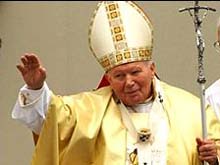 On April 2, 2005, Pope John Paul II passed away. Pope Wojtyla, whom more people saw with their own eyes, “live,” than any other person in world history, broke every possible record set by his predecessors. He broke the barriers between peoples and religions, played a huge role in the bloodless overthrow of communism, and led the third, "Catholic," wave of democratization. John Paul II personified the church, which seeks to open up the world and not isolate itself with its anathemas, which listens to the signs of the times, and is ready to return to evangelical simplicity and do away with the arrogant luster of medieval monarchs.
On April 2, 2005, Pope John Paul II passed away. Pope Wojtyla, whom more people saw with their own eyes, “live,” than any other person in world history, broke every possible record set by his predecessors. He broke the barriers between peoples and religions, played a huge role in the bloodless overthrow of communism, and led the third, "Catholic," wave of democratization. John Paul II personified the church, which seeks to open up the world and not isolate itself with its anathemas, which listens to the signs of the times, and is ready to return to evangelical simplicity and do away with the arrogant luster of medieval monarchs.
Joseph Ratzinger, who on April 18, 2005, together with other cardinals, was at the conclave, represented the Christians who always understood that from the time of Jesus to the present day there is small flock that goes not the broad way but the narrow path to salvation. They are the salt of the world, but not the world itself. The church is not supposed to listen to the signs of the times, but time has to adjust to the signs given by the church.
Joseph Ratzinger had a long academic career, the invincible logic of a professor of dogmatic theology at prestigious universities, and brilliant erudition. He had been prefect of the Congregation for the Doctrine of the Faith (formerly the Supreme Sacred Congregation of the Roman and Universal Inquisition) for a quarter of a century, ties with the 140 theologians condemned for breaking boundaries that seemed inviolable to the cardinal, and wrote a document giving directives on the use of the expression “sister churches” and signed the Declaration Dominus Iesus – documents that have disappointed many Orthodox and especially Protestants.
Cardinal Ratzinger was sometimes included in the list of candidates for the papacy, but usually as a formality. He looked too strict, old, too European and overly intellectual, not charismatic or telegenic. Even the experts who admired him asked for other nominations. Vaticanists tried to predict the position of each of the 115 cardinals who were to vote (then, incidentally, it was found that that there were not enough votes of those who under no circumstances would vote for Ratzinger to block his candidacy.) They considered many battle scenarios at the conclave: a candidate of the First World against the Third, an Italian against a Latin American, a traditionalist against, conventionally, a modernist, a Vatican bureaucrat versus a diocesan cardinal, and so on. But what happened, happened, and it happened in a flash. Ratzinger was elected already on the second day of the conclave, on April 19, after the fourth ballot.
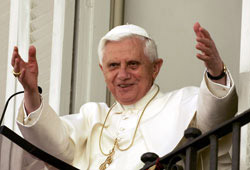 He chooses the name Benedict, in honor of St. Benedict of Nursia, the patron saint of Europe, and thus clearly defines his area of concern. Benedict XVI cannot accept the decline of the European Christian civilization; he is looking for allies to form a united front against atheism and pervasive cynicism.
He chooses the name Benedict, in honor of St. Benedict of Nursia, the patron saint of Europe, and thus clearly defines his area of concern. Benedict XVI cannot accept the decline of the European Christian civilization; he is looking for allies to form a united front against atheism and pervasive cynicism.
The stimulus, which for Pope John Paul II was communism, for Ratzinger is secularism and radical Islam. In September 2006, he lectured in Regensburg and quoted a medieval Byzantine emperor who is critical of the teachings of the Prophet Mohammad. Benedict XVI himself called the emperor’s expression arrogant, but he did remember the quote. Then it seemed that a distinguished theologian forgot that he was the pontiff; his words will spread far beyond the academic and Christian circles. But over time, the situation started to look a bit different. Did the pope not want to “pull,” maybe provoke, the world of Islam into the global dialogue? Did he not intend to go to the very heart of Islam, to expose that which disturbs the whole world and find something that can give the world hope? Does the German pope advocate rigid demarcation lines between religions and within Christianity – between the Catholic Church and all other Christians – as part of a larger strategy to fight against relativism and refusal in finding the truth?
V.
During the first decade of the twenty-first century there were no sings of a new a world religion or of the triumphs of new religions as old ones decline.
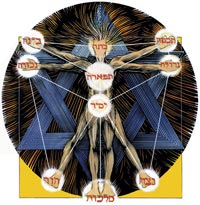 But, on the other hand, the truly visible phenomenon has became the fringe religious subcultures: independent African churches, claiming to offer a unique connection between Christianity and the local traditional African beliefs; independent African-Latin American churches; a meditative European culture; neo-Orientalist beliefs and practices in the West. Finally, the movement to study Kabbalah, which became an big player in the market of “senses of life,” significantly spread beyond Judaism and became attractive to many Western pop idols, including singer Madonna, actress Demi Moore, and soccer player David Beckham. The website kabbalah.info, created by the founder of the International Academy of Kabbalah Michael Laitman, was recognized by the Encyclopedia Britannica as one of the biggest religious sites on the Web in terms of the number of visitors.
But, on the other hand, the truly visible phenomenon has became the fringe religious subcultures: independent African churches, claiming to offer a unique connection between Christianity and the local traditional African beliefs; independent African-Latin American churches; a meditative European culture; neo-Orientalist beliefs and practices in the West. Finally, the movement to study Kabbalah, which became an big player in the market of “senses of life,” significantly spread beyond Judaism and became attractive to many Western pop idols, including singer Madonna, actress Demi Moore, and soccer player David Beckham. The website kabbalah.info, created by the founder of the International Academy of Kabbalah Michael Laitman, was recognized by the Encyclopedia Britannica as one of the biggest religious sites on the Web in terms of the number of visitors.
As for the new religions, every year the London-based INFORM (Information Network Focus On Religious Movements) receives information about almost 150 new religions. However, usually the very fact of their existence remains unknown to anyone outside the friends and families of the members. Moreover, according to Rodney Stark, only one in every thousand new religious groups attracts more than 100 thousand supporters. But even most new religions that achieve such modest results just barely make religious history. Over the past decade, however, researchers have suggested taking a closer look at the “hypnotizing plurality” of alternative religions in Brazil, which makes the religious landscape of super-diverse California (David Hess) look modest and obscure, and this plurality was even predicted to be “an indicator of the upcoming religious development” (James Beckford).
But in any case, contemporaries seem to have a bigger interest in the “old” Christianity than in all the new religions put together: 33,000 copies of the Bible were being published daily; the number of people who attended the Alpha Course – a program in the basics of Christianity – increased from 3.8 million in early 2001 to 15 million in June 2010.
Probably what made religion stand out the most in the ’00s was the Internet. A modest but promising phenomenon of the 1990s, it literally exploded in the 2000s. The number of religious search engines, spiritualistic, religious, denominational, and congregation sites grew at a stunning pace. Already by the middle of the decade, nearly two-thirds of American Internet users have connected to the Web for religious purposes – that is 82 million Americans turned to the Internet for their spiritual needs. Of the 128 million Internet users in the U.S., 38 percent sent letters with religious content, a third read religious news, 17 percent looked up the time and place for church services, and 7 percent made donations to religious organizations via the Internet. The fact that the sites of religious organizations offer virtual participation in worship, browsers saw the triumph of cyber churches, which are taking the place of traditional religious communities. But research conducted by the Pew Center gave an unexpected result: people who most frequently used the Internet for religious purposes (at least three times a week) were the most active participants in “offline” religious life.
Less clear was the development of what is generally called “spirituality,” whose course at the end of the 1990s seemed invincible. Seminars in spirituality gathered a huge number of people in the 2000s; the trend to search for sense and harmony, inner comfort, and physical health as part of spiritual health outside organized religion was very apparent over the last decade. But first of all, it remained mostly a Western trend, second, it did not undermine institutionalized religion, and third, the division between traditional church spirituality and non-church spirituality, which deepened in the decade, began to narrow in the West – the church became more attentive to the people whose spiritual needs remained dissatisfied by the church, who were pushed away by its dogmatism, formalism, and stereotypical service.
Religion in the 2000s was not pushed from the public sphere to the private sphere. It remained part of politics in the Middle East, in the U.S., in India and in the Eurasian expanse. It gained new ground: post-communist countries in the late 1980s and the 1990s and China in the 2000s. It is increasingly said that this country is undergoing a “religious awakening”; even according to officially published research, 31.4 percent of Chinese adults are believers – an enormous number considering China has a population of 1.3 billion.
Furthermore, religion has played its part in culture – sometimes a very vibrant part. Mel Gibson’s 2004 film, which depicts the last 12 hours of Jesus’s life in Aramaic and Latin, was one of the top grossing films of all times.
Finally, neither psychoanalysis nor the environmental movement – which claimed to be the secular religion of the new century, also in countries where last century communism and nationalism reigned – could replace traditional religion. But if we look at the fact that Christianity includes two billion people and Islam more than a billion, then we understand that no ideology in the modern world can compete with the religious one.
VI.
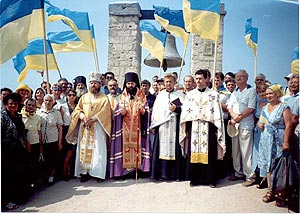 In terms of the continuity and variability of religion in Ukraine in the 2000s, the situation has remained largely the same in. First, the main indicators of Ukrainians’ religiosity remained the same throughout most of the decade. According to studies by the Razumkov Center conducted between 2000 and 2008, 57–60 percent of respondents considered themselves believers, 9–11 percent nonbelievers. Another 19–22 percent considered themselves somewhere between believers and nonbelievers. Like everywhere in the world, older people are more religious, women are more religious than men, people with less education more than those with higher educations, villagers more than city dwellers. In reality, the gap in religiosity between age groups in Ukraine is not as large as in EU countries. In addition, 20 to 30-year-olds are more likely to have received at least some elementary religious education in the family than respondents from their parents’ generation. Furthermore, all age groups tend to believe that society has become more religious compared to past (that is the Soviet past). Finally, western Ukraine has consistently demonstrated significantly higher religiosity than eastern and southern Ukraine.
In terms of the continuity and variability of religion in Ukraine in the 2000s, the situation has remained largely the same in. First, the main indicators of Ukrainians’ religiosity remained the same throughout most of the decade. According to studies by the Razumkov Center conducted between 2000 and 2008, 57–60 percent of respondents considered themselves believers, 9–11 percent nonbelievers. Another 19–22 percent considered themselves somewhere between believers and nonbelievers. Like everywhere in the world, older people are more religious, women are more religious than men, people with less education more than those with higher educations, villagers more than city dwellers. In reality, the gap in religiosity between age groups in Ukraine is not as large as in EU countries. In addition, 20 to 30-year-olds are more likely to have received at least some elementary religious education in the family than respondents from their parents’ generation. Furthermore, all age groups tend to believe that society has become more religious compared to past (that is the Soviet past). Finally, western Ukraine has consistently demonstrated significantly higher religiosity than eastern and southern Ukraine.
In the 2000s religious institutional development with its already saturated religious network continued to move from the western regions to the east (this trend, however, began back in the second half of the 1990s).
At the end of the decade social scientists began to record a growth in self-declared religiosity: in November 2010, over 70 percent of respondents surveyed by the Razumkov Center called themselves believers. But the high level of self-declared religiosity was combined with a much lower level of religious practice (the study found 16–20 percent attend worship at least monthly). This is below the average in the pyramid of European countries aligned by religious behavior. Along with this, the difference in behavior in various regions of the country is very perceptible: the average resident of Kyiv, according to the results of a European research program in values, attends church 11–12 times a year; in the west the figure is 22–23 times; in the east and south, 7–8 times. This means that western Ukrainians attend church as often as Italians, Portuguese, and Slovaks; Kyivans as often as Slovenians, Swiss, British, and Dutch; and Ukrainians in the south and east as often as the French, Estonians, Latvians, and Albanians, but more often than Russians, Czechs, East Germans, Swedes, and Danes.
The question about the existence of correlations between types of religious culture and religious behavior and state of public morality remains debated, including in Ukraine. On the one hand, it is clear that according to certain parameters the West looks different from the East. In 1999, for example, Sevastopol had by far the highest number of interrupted pregnancies; Luhansk region, second; Zaporizhia, third; Ternopil and Ivano-Frankivsk and Rivne, last, second to last, and third to last, respectively. In 2007 the number of HIV cases per 100 thousand people in Transcarpathia was 3.5; in Ivano-Frankivsk, 7; in the Chernivtsi Oblast, 7.4; in Dnipropetrovsk region, 78.2; in Donetsk region, 82.7; in Kherson, 96.6. The number of people who suffered from crimes per 100 thousand people was 582 in Greece, 698 in Zaporizhia, 724 in Donetsk; 233 in Chernivtsi, 249 in Ivano-Frankivsk, and 237 in Ternopil. There is roughly the same disproportion in suicide, AIDs cases, number of convicted criminals, etc. The figures are telling, but in order to understand how important the religious factor is, and how much the sociocultural, demographic, economic, historical factors are, a whole series of special studies are needed.
Of course, however, the general increase in religiosity, building of churches, and the appeal of the church, especially in the turbulent 1990s, was not accompanied by the rise of public morality – rather the opposite, considering the level of crime, the number of abandoned children and elderly, the state of business ethics, and so on.
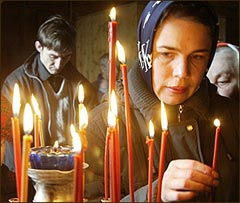 Speaking about Ukrainian religion, one cannot overlook one of the lowest in central and eastern Europe levels of real participation in the activity of certain religious organizations. Only slightly more than 7 percent of Ukrainians have “close” or “very close” ties with the church. This is significantly lower than the percentage in Poland, where more than half of its citizens have such ties, and Croatia (about half), as well as the percentage in Slovenia (about one third), Hungary (one fifth), and Lithuania (every sixth), and is about the same as in Czech Republic. It is worth noting that the Ukrainians interviewed in the program Aufbruh ranked active participation in the community only tenth place among criteria of Christianity: “belief in God” was ranked first, followed by the Ten Commandments, care for elders, regular prayer, premarital abstinence, helping others, attending church every Sunday, seeking maximum results, proselytizing, rejection of contraceptives.
Speaking about Ukrainian religion, one cannot overlook one of the lowest in central and eastern Europe levels of real participation in the activity of certain religious organizations. Only slightly more than 7 percent of Ukrainians have “close” or “very close” ties with the church. This is significantly lower than the percentage in Poland, where more than half of its citizens have such ties, and Croatia (about half), as well as the percentage in Slovenia (about one third), Hungary (one fifth), and Lithuania (every sixth), and is about the same as in Czech Republic. It is worth noting that the Ukrainians interviewed in the program Aufbruh ranked active participation in the community only tenth place among criteria of Christianity: “belief in God” was ranked first, followed by the Ten Commandments, care for elders, regular prayer, premarital abstinence, helping others, attending church every Sunday, seeking maximum results, proselytizing, rejection of contraceptives.
Hierarchy and clergy are very concerned over the low intensity of parish life and poor communication of Christians, above all among Orthodox, with the religious community and, more broadly, with the church. Kyiv priest Andrew Dudchenko calculated that the Sunday divine services in all Orthodox and Catholic churches in the capital attract no more than 100 thousand people and calls for staunch evangelization of the Ukrainian society and catechization of “nominal” Christians.
A specific (though not unique) religious culture – which is organized not around the church’s core system of beliefs and practices as much as a set of values – is forming in Ukraine that crosses religious boundaries and which creatively unites elements of civil religion with folk symbols, customs, and behavioral norms. (The church often finds these beliefs to be dubious.)
Religion exists in the public space like drops of mercury on the floor. They can be invisible for a long time but are able to suddenly merge into a large grouping, react with the environment, and manifest in resonant and unpredictable ways. (Something similar is sometimes called “diffused religion.”)
Although most people do not attend church regularly, the majority supports staunch church behavior, which increasingly id being accepted by the public. (British researcher Grace Davie called this “surrogate religion.”)
Government officials and politicians, public figures, pop stars, and athletes perceive ecclesiasticism as part of a respectable image; icons have become an indispensable part in officials’ offices. There is not a single public figure – be it in politics, academia, culture, art, etc. – who would openly declare his or her atheism. All of the presidents of Ukraine, prime ministers, and top officials fund churches and readily turn to religious symbols in their rhetoric. The religious factor played a part, often a prominent part, in every single election campaign of the decade
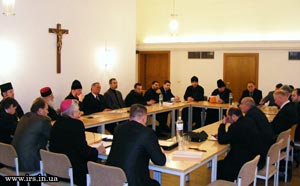 Inactive church life and low level of involvement in the affairs of religious communities is somehow associated with very high level of confidence in the church –not in a particular religious organization but in the church as an institution that is not responsible for social afflictions and which is perceived as a kind of ideal type. All studies consistently show that the level of trust in the church (not in a specific one but in the church in general) is higher than any other institution. Interchurch conflicts, scandals in the church community, the misbehavior of the clergy, disclosure of financial abuses have not affected its image. The church is still the most trusted. The number of people who value its social mission has increased in the last decade, and more than a quarter of respondents believe that “most clerics are deeply moral and spiritual,” and another 44 percent believe that “clerics are the same as most of us – with virtues and sins.” Less than 10 percent believe that property currently owned by the state should not be returned to the church (Razumkov Center, November 2010).
Inactive church life and low level of involvement in the affairs of religious communities is somehow associated with very high level of confidence in the church –not in a particular religious organization but in the church as an institution that is not responsible for social afflictions and which is perceived as a kind of ideal type. All studies consistently show that the level of trust in the church (not in a specific one but in the church in general) is higher than any other institution. Interchurch conflicts, scandals in the church community, the misbehavior of the clergy, disclosure of financial abuses have not affected its image. The church is still the most trusted. The number of people who value its social mission has increased in the last decade, and more than a quarter of respondents believe that “most clerics are deeply moral and spiritual,” and another 44 percent believe that “clerics are the same as most of us – with virtues and sins.” Less than 10 percent believe that property currently owned by the state should not be returned to the church (Razumkov Center, November 2010).
Finally, the religious culture, which was formed in Ukraine, has remarkable layers that are unlikely to bring any good. Semi-feudal practices of the “overlord” – usually a deputy and businessman – “holding” a region, lead to the subordination of the clergy. “Big money” tries to determine not only the lives of some Orthodox parishes but also dioceses and even governing centers. They affect the movement of clergy and new appointments. Since 2010 there have been attempts to convert Orthodoxy into an ideology. Such a concept, which has yet to be articulated, would outline the new government-approved historiosophical scheme (“Only our Orthodox faith and our church helped us all, the Ukrainian people, survive these trials”) and authorize its new geopolitical course and humanitarian policy.
VII.
At the beginning of the first decade of the century, Ukraine passed, so it seemed, the most acute phases of the inter-Orthodox and Orthodox-Greek Catholic conflict. In the country a fragile balance was established between the centers of religious forces, which have comparable support in society and in the political establishment. These centers of power have learned to compensate for the lack of various resources with other means: material with public opinion, understanding with the central government by harmony with local authorities, and so forth. This also worked to strengthen the balance between them. Statements on the need to break the balance were perceived as rhetorical formulas and as a way to test the willingness of the government and public opinion – for this the sides lacked sufficient strength and the state realized the need to maintain the status quo as a safeguard for preserving civil peace.
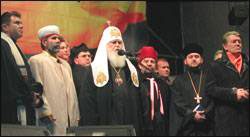 During the presidential campaign of 2004, the fragile religious balance had to pass the “destabilizing scenario.” There were efforts to tear up the country across religious lines. The team for the “single candidate of the government” viewed religion as a resource to mobilize “theirs” against “outsiders,” and as an effective propaganda and organizational mechanism. But during the days of Maidan this mechanism was opposed not by a different church or inter-church mechanism but by religion as a symbolic space that reached beyond the ordinary and where people request justice from higher powers. Then it seemed that religion could be a major unifying and nation-building force, not by demarcating religious territories but by freeing politics of cynicism and providing it with values and a moral dimension
During the presidential campaign of 2004, the fragile religious balance had to pass the “destabilizing scenario.” There were efforts to tear up the country across religious lines. The team for the “single candidate of the government” viewed religion as a resource to mobilize “theirs” against “outsiders,” and as an effective propaganda and organizational mechanism. But during the days of Maidan this mechanism was opposed not by a different church or inter-church mechanism but by religion as a symbolic space that reached beyond the ordinary and where people request justice from higher powers. Then it seemed that religion could be a major unifying and nation-building force, not by demarcating religious territories but by freeing politics of cynicism and providing it with values and a moral dimension
But in any case, the country was divided more than ever on the eve of Ukrainian independence. According to the Institute of Sociology, over 6 percent of Ukrainian citizens admitted that they experienced major conflicts with friends or relatives over the elections and sometimes these conflicts were still not settled. The number of confrontations on the streets and on transport, in shops and establishments providing consumer services to people of other political persuasions significantly increased. The number of people who went a month without such incidents decreased. There was an increased level of xenophobic behavior as well as protest moods. There were more people willing to go out and defend their rights illegally. The state leadership had the urgent task of stitching up the country. But it had neither the full grasp of the problems, nor a merging strategy, nor the will to implement it. This greatly influenced the future developments in the country, including in the religious and social spheres.
VIII.
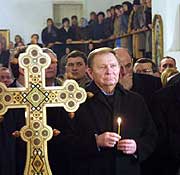 In the early 1990s, the Ukrainian government announced that it had a policy for the religion sphere and even recorded it in law. The priorities of church policy for President Kuchma were maintaining stability, ensuring the loyalty of the religious community, and gaining the support of the hierarchy, as well as ideologically strengthening the process, which his predecessor, and later he, called “state building.” The existence of rival Orthodox jurisdictions did not help the process. In addition, during the pan-Orthodox summit in Jerusalem marking 2,000 years of Christianity, Leonid Kuchma very clearly, with the help of the language of the State Protocol and church ritual, understood the implication of an autocephalous church for a country where most people profess Orthodoxy. In the campaign of the heads of the Russian, Georgian, Romanian, Bulgarian and other countries, who were accompanied by “their” church primates, the Ukrainian president could not feel equal. Upon returning to Kyiv, the president gave a speech about the importance of a national Orthodox Church, where he strongly criticized the forces standing in its way. Kuchma was strongly devoted to this idea. He wrote letters to Presidents Yeltsin and Putin asking for their support, appealed to the Jubilee Hierarchical Council of the Russian Church, and met with Patriarch Alexy II and Bartholomew I. And, as everybody understood, it was a step away from Russian dependence and toward the consolidation of Ukrainian sovereignty, as was the visit of Pope John Paul II to Ukraine. The implication of the 2001 visit, which took place despite strong opposition from both the church and the state of Russia, was felt more deeply in Russia than in Ukraine. It is difficult to imagine a papal visit take placing in Ukraine today against such opposition.
In the early 1990s, the Ukrainian government announced that it had a policy for the religion sphere and even recorded it in law. The priorities of church policy for President Kuchma were maintaining stability, ensuring the loyalty of the religious community, and gaining the support of the hierarchy, as well as ideologically strengthening the process, which his predecessor, and later he, called “state building.” The existence of rival Orthodox jurisdictions did not help the process. In addition, during the pan-Orthodox summit in Jerusalem marking 2,000 years of Christianity, Leonid Kuchma very clearly, with the help of the language of the State Protocol and church ritual, understood the implication of an autocephalous church for a country where most people profess Orthodoxy. In the campaign of the heads of the Russian, Georgian, Romanian, Bulgarian and other countries, who were accompanied by “their” church primates, the Ukrainian president could not feel equal. Upon returning to Kyiv, the president gave a speech about the importance of a national Orthodox Church, where he strongly criticized the forces standing in its way. Kuchma was strongly devoted to this idea. He wrote letters to Presidents Yeltsin and Putin asking for their support, appealed to the Jubilee Hierarchical Council of the Russian Church, and met with Patriarch Alexy II and Bartholomew I. And, as everybody understood, it was a step away from Russian dependence and toward the consolidation of Ukrainian sovereignty, as was the visit of Pope John Paul II to Ukraine. The implication of the 2001 visit, which took place despite strong opposition from both the church and the state of Russia, was felt more deeply in Russia than in Ukraine. It is difficult to imagine a papal visit take placing in Ukraine today against such opposition.
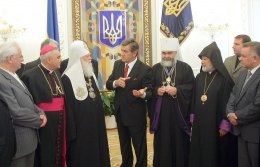 President Yushchenko also dreamed of one national church. He, along with many in his entourage, did not believe that patching up the divided country would ultimately lead to Orthodox unification but that the church community would become an engine of nationwide consolidation. “Uniting the churches” seemed easier and more attractive than the daily political, economic, legal, and administrative work in “uniting Ukraine.” A good example of this happened on January 12, 2007: while the president discussed with the senior clergy of the Kyivan Patriarchate the possibility of creating a joint theological commission with the UOC-MP, the faction of Yulia Tymoshenko and the Party of Regions passed a law that reduced the president’s control of the government. But even what Yushchenko tried to do in the church sphere was demonized both domestically and abroad. In the information war that Russia waged against Ukraine, the religious front was not spared. Having expressed its “righteous anger” in the Ukrainian state intervening in the affairs of the Ukrainian churches, the Kremlin prepared for its own intervention, and also united the Russian Orthodox Church with the ROCOR, destroyed the Orthodox outside the Moscow Patriarchate, and began censoring religious literature in Russia.
President Yushchenko also dreamed of one national church. He, along with many in his entourage, did not believe that patching up the divided country would ultimately lead to Orthodox unification but that the church community would become an engine of nationwide consolidation. “Uniting the churches” seemed easier and more attractive than the daily political, economic, legal, and administrative work in “uniting Ukraine.” A good example of this happened on January 12, 2007: while the president discussed with the senior clergy of the Kyivan Patriarchate the possibility of creating a joint theological commission with the UOC-MP, the faction of Yulia Tymoshenko and the Party of Regions passed a law that reduced the president’s control of the government. But even what Yushchenko tried to do in the church sphere was demonized both domestically and abroad. In the information war that Russia waged against Ukraine, the religious front was not spared. Having expressed its “righteous anger” in the Ukrainian state intervening in the affairs of the Ukrainian churches, the Kremlin prepared for its own intervention, and also united the Russian Orthodox Church with the ROCOR, destroyed the Orthodox outside the Moscow Patriarchate, and began censoring religious literature in Russia.
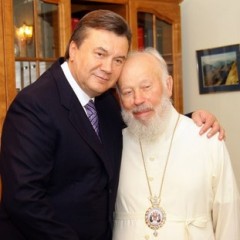 As it turned out, the fourth elected president of Ukraine, Viktor Yanukovych, also had a vision of a united Orthodox Church in Ukraine. This vision seems to have been formed under different but unidirectional influences. One such influence was from the ecclesiastic of the future president Schema-Archimandrite Zosima Sokur, who said, “in the case of Ukraine departing from Moscow, no matter if the autocephaly is lawful or not, the tie with the Kyivan Metropolitan automatically breaks.” This is one of the favorite passages of the opponents of an independent Ukrainian church. It is also obvious that Viktor Yanukovych has largely adopted the thesis – popular among the hierarchs and spokespersons of the Moscow Patriarchate – that the Kyiv Patriarchate is resting solely on political support and will fall as soon as it is removed. It is hard to imagine that Yanukovych, who in the first year of his presidency met with the Patriarch of Moscow three times, has never discussed with him the problems of the Ukrainian division. And even harder to imagine is that the patriarch proposed to the president a model for a solution that is friendly toward the “schismatics.” In any case, the pressure on priests and the community of believers of the Kyivan Patriarchate, who are strongly urged to join the Moscow Patriarchate, has become a sign of the “new religious policy,” as has the favoritism and friendship with only one church – the Ukrainian Orthodox Church of the Moscow Patriarchate. This was a real delight in some circles of the church, confusion in others, and suspicion in the society. In late 2010, less than 30 percent of people surveyed by the Razumkov Center believed that “the government treats all religious organizations in Ukraine equally.” Instead, nearly a quarter said that “there is a church, which the government treats better than others,” and another 11.3 percent believed that “the government is increasing the power of one church.”
As it turned out, the fourth elected president of Ukraine, Viktor Yanukovych, also had a vision of a united Orthodox Church in Ukraine. This vision seems to have been formed under different but unidirectional influences. One such influence was from the ecclesiastic of the future president Schema-Archimandrite Zosima Sokur, who said, “in the case of Ukraine departing from Moscow, no matter if the autocephaly is lawful or not, the tie with the Kyivan Metropolitan automatically breaks.” This is one of the favorite passages of the opponents of an independent Ukrainian church. It is also obvious that Viktor Yanukovych has largely adopted the thesis – popular among the hierarchs and spokespersons of the Moscow Patriarchate – that the Kyiv Patriarchate is resting solely on political support and will fall as soon as it is removed. It is hard to imagine that Yanukovych, who in the first year of his presidency met with the Patriarch of Moscow three times, has never discussed with him the problems of the Ukrainian division. And even harder to imagine is that the patriarch proposed to the president a model for a solution that is friendly toward the “schismatics.” In any case, the pressure on priests and the community of believers of the Kyivan Patriarchate, who are strongly urged to join the Moscow Patriarchate, has become a sign of the “new religious policy,” as has the favoritism and friendship with only one church – the Ukrainian Orthodox Church of the Moscow Patriarchate. This was a real delight in some circles of the church, confusion in others, and suspicion in the society. In late 2010, less than 30 percent of people surveyed by the Razumkov Center believed that “the government treats all religious organizations in Ukraine equally.” Instead, nearly a quarter said that “there is a church, which the government treats better than others,” and another 11.3 percent believed that “the government is increasing the power of one church.”
These are not just “localized beliefs,” for President Viktor Yanukovych has acquired all power in the country and without the thrust from above the phenomenon would not be a trend. One must understand that since 2010 a united Orthodox Church is thought of as really one united Ukrainian Orthodox Church subordinated to the Moscow Patriarchate, which has to absorb at least the central Ukrainian part of the UOC-KP, and simultaneously the UAOC. Its unity is not the consolidation of the Ukrainian Orthodox but unity with Moscow.
The president (together with the prime minister) went to the Patriarchal Council of Economics and Ethics (no other head of state of countries that are members of the canonical territory of the ROC did this) and made, fulfilling his duties – that is, as stated in the Constitution – on behalf of Ukraine, a number of steps that were meant to demonstrate the seriousness of changes in church-state relations.
IX.
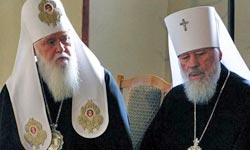 The public did not remain indifferent toward the issue of a national Orthodox Church throughout the entire decade. Although this issue is by far not one of the most worrisome for Ukrainians, surveys have consistently recorded that there are more supporters than opponents of the idea in the country. The media enthusiastically quoted even the Orthodox hierarchs’ most commonplace statements declaring their readiness to start a dialogue with each other. The segment of the Ukrainian society concerned over Orthodox unity (which is not small, according to research) is in suspense and reading the sings. Already few people remember the enthusiasm over the negotiations between Constantinople and Moscow Patriarchate on the situation in Ukraine, the signing of agreements between the UOC-KP and the UAOC in Fener that were impossible to keep (2001), numerous trips to Moscow and Istanbul, letters, addresses of Ukrainian public figures, including requests not only to Alexy II and Bartholomew I and the Jubilee Hierarchal Council of the ROC but also to Yeltsin and Putin to help solve resolve the Ukrainian Orthodoxy issues.
The public did not remain indifferent toward the issue of a national Orthodox Church throughout the entire decade. Although this issue is by far not one of the most worrisome for Ukrainians, surveys have consistently recorded that there are more supporters than opponents of the idea in the country. The media enthusiastically quoted even the Orthodox hierarchs’ most commonplace statements declaring their readiness to start a dialogue with each other. The segment of the Ukrainian society concerned over Orthodox unity (which is not small, according to research) is in suspense and reading the sings. Already few people remember the enthusiasm over the negotiations between Constantinople and Moscow Patriarchate on the situation in Ukraine, the signing of agreements between the UOC-KP and the UAOC in Fener that were impossible to keep (2001), numerous trips to Moscow and Istanbul, letters, addresses of Ukrainian public figures, including requests not only to Alexy II and Bartholomew I and the Jubilee Hierarchal Council of the ROC but also to Yeltsin and Putin to help solve resolve the Ukrainian Orthodoxy issues.
The “Ukrainian issue” has constantly worried the Moscow Patriarchate. It is negotiating with Constantinople to link its activity in the Ukrainian direction, as well as to include religious issues in the catalog of Russian-Ukrainian interstate relations. In organizing the visits of John Paul II (2001) and Patriarch Bartholomew I (2008) to Ukraine, in moving the center of the Ukrainian Greek Catholic Church from Lviv to Kyiv, and it its effort to unite the Orthodox, the Ukrainian state felt opposition not only from the Moscow Patriarchate but also from the Russian state. A special department for religious matters was even created in Russia’s Foreign Ministry. Orthodoxy, as the Foreign Ministry of the Russian Federation stressed, is “an integral part of its efforts to ensure the distinctive role of Russia in world affairs.” By actively mobilizing the old Russian diaspora, “uniting its compatriots,” Russia wants to regain the “historical role of the patron and defender of the Orthodox Churches.”
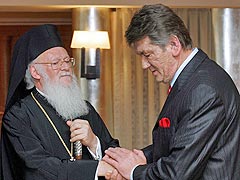 In Ukraine, meanwhile, Maidan Square brings Viktor Yushchenko into office. The expectation that the “Orthodox issue” will finally be resolved is rapidly increasing. The head of the state does not tire of explaining the importance of a national church in Ukraine; the UOC-Moscow Patriarchate is softening its rhetoric on “schismatics.” The UOC Hierarchal Council (2007) condemns “political Orthodoxy” and calls to “treat our brothers and sisters who are temporarily outside the jurisdiction of the church with Christian love and without hostility.” Then it adopted amendments to the statute on the management of the UOC, which pro-Russian environments in the UOC called the path to actual autocephaly without its formal declaration.
In Ukraine, meanwhile, Maidan Square brings Viktor Yushchenko into office. The expectation that the “Orthodox issue” will finally be resolved is rapidly increasing. The head of the state does not tire of explaining the importance of a national church in Ukraine; the UOC-Moscow Patriarchate is softening its rhetoric on “schismatics.” The UOC Hierarchal Council (2007) condemns “political Orthodoxy” and calls to “treat our brothers and sisters who are temporarily outside the jurisdiction of the church with Christian love and without hostility.” Then it adopted amendments to the statute on the management of the UOC, which pro-Russian environments in the UOC called the path to actual autocephaly without its formal declaration.
Relations with Constantinople are noticeably intensifying. The culmination was the Ecumenical Patriarch’s visit to Kyiv in summer 2008, where Patriarch Bartholomew I was met with unprecedented honor. It is expected that the Constantinople Patriarchate will assume jurisdiction over the Ukrainian Orthodox Churches that declared themselves independent from Moscow. Having two canonical jurisdictions on the territory of one country is not ideal, in terms of canon law and for the consolidation of the Ukrainian society. But under the circumstances, where the Moscow Patriarchate and the Russian government have demonstrated their disinterest in solving the Ukrainian question, it is a solution for millions of Orthodox, and for the future of Orthodoxy in Ukraine. And both religious and secular Moscow will eventually acknowledge that they did everything they could to stop such developments. But for Orthodoxy in Ukraine what is happening in Kyiv, not in Moscow or Istanbul, has always been the most important. This time, Patriarch Filaret has not agreed to the terms of joining his church with the Patriarchate of Constantinople. These conditions, as the patriarch later explained, included his abdication, the conversion of the UOC-KP into a metropolitanate of the Constantinople Patriarchate, and the election of three candidates to the Kyivan throne by Ukrainian bishops for the Ecumenical Patriarch to elect the Metropolitan of Kyiv. Autocephaly for the Metropolitanate of Kyiv, according to the patriarch, would be pushed aside indefinitely.
None of this has happened and the Moscow Patriarchy breathed easily. But Metropolitan Kirill, who was elected head of the ROC in 2009, did what he could to prevent a repeat of his dramatic summer in 2008. The rhetoric against Constantinople changed, the dismissive assessments of the number of faithful Ecumenical Patriarch disappear from the official church discourse; instead, there are assurances of eternal gratitude to the throne, where “we have adopted the Orthodox faith and Christian light.” And on the eve of Patriarch Kirill’s visit with Patriarch Bartholomew I (July 2009) there is talk about a new page in the relations between the patriarchates and that the Moscow Patriarchate may help the Constantinople throne solve its own problems – in exchange, of course, for the resolution of problems that concern to Moscow.
In December of the same year, the Inter-Orthodox Preparatory Commission met in Chambesy to develop proposals for the All-Orthodox Preparatory Council about the problem of autocephaly and autonomy. The Preparatory Commission prepared a preliminary document that provides a mechanism for proclaiming autocephaly, which, according to Patriarch Filaret, makes proclaiming autocephaly impossible in the future. Indeed, the prospects look bleak. The part of the church that seeks autocephaly sends a request to the mother church (which never happy about receiving such appeals). Further, if the mother church makes a positive decision at its national synod, the case goes to the Ecumenical Patriarchate, and it informs all local churches and discusses the presence of Orthodox consensus on the issue. If, suppose, the mother church lets her daughter go, and none of the national churches has any complaints about the newly acquired autocephaly, if political factors miraculously do not interfere in the process, then the Ecumenical Patriarch gives Tomos, which is then confirmed by the signatures of the heads of all the national churches. One cannot imagine that the Ukrainian or the Macedonian Church could obtain autocephaly this way.
The Orthodox, however, who at any cost want to, as once wrote Vasyl Lypkivsky, “jump out from under Moscow,” indicate at least three things: the preliminary character of the document; the fact that the Constantinople Church considers itself the mother church, where the “Ukrainian people hold a special,” as once said Patriarch Bartholomew I, “one might even say a central place” in its heart; and also the fact that the project provides opportunities to find a canonical solution of the matter in the case of debate over granting autonomy to the two autocephalous churches of various church communities in one country. This applies to Estonia and possibly to Ukraine. This means that having hindered Orthodoxy in Ukraine’s path toward autocephaly, the Ecumenical Patriarchate has preserved the possibility to absorb a church organization in Ukraine, to which it will grant autonomy.
X.
Inefficiency and irresponsibility, which was displayed by the Orange administration, failure to meet the expectations and dreams of millions of Ukrainians, not only brought Viktor Yanukovych to office but polarized identities in the country, including religious identities. From the early 1990s to the late 2000s, there were significantly more people who declared their affiliation to the Orthodox Church-Kyivan Patriarchate than those who declared their affiliation to the Orthodox Church-Moscow Patriarchate. If there had been an option on the survey to choose “simply Orthodox,” a greater majority would have chosen this option. Thus the people, who as a whole have a very weak connection to institutionalized religion, manifested their national and cultural identity. This identity is more associated with Kyiv than with Moscow. And thus, despite the fact that the UOC-MP had significantly more communities than the UOC-KP, the Kyiv Patriarchate had a higher percentage in the survey.
The situation began to change in 2008 when one of the opinion polls revealed that adherents of the Moscow Patriarchate make up a small majority. Then in November 2010 the Razumkov Center found that UOC-MP adherents made up a significant majority over the UOC-KP – 23.6% versus 15.1% (UAOC – 0.9%).
Why were more people declaring their loyalty to the UOC-MP? First, Orthodoxy in Ukraine is growing much more in the eastern and southern regions than it is in the center, and more than in the west, where the church network is already very saturated. Most of the new Orthodox communities that are appearing in the south and east belong to the Moscow Patriarchate. Secondly, obviously, the UOC-KP in the eyes of new Orthodox believers is not capable of becoming a universal Orthodox Church, whose further development is due to the quality of religious life, theology, professional and non-professional education, and so forth, and not just a national idea. The general Orthodox identity is polarizing, which reflects the polarization of identities in the Ukrainian society. “Simply Orthodox” believers continue to make up the relative majority, but their presence is being reduced. Some call themselves this so to not declare a certain identity. The answer to this question is becoming more relevant as certain events unfold in the country. The key question depends on what identity is chosen. The results, however, do not indicate that Russian identity is beginning to dominate the Ukrainian one: in the Razumkov Center survey from November 2010, only 0.8 percent of the respondents chose the Russian Church.
XI.
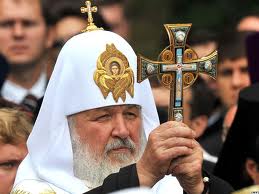 The polarization of identities deepened in summer 2009, when the recently crowned 16th patriarch of the Russian Orthodox Church, Patriarch Kirill, came to Ukraine and tells the much disappointed and pessimistic Ukrainian society to rethink its historical choice. The West can offer you nothing, he tells them. Holiness is Rus’. Together we are invincible and interesting to the world. When we unite, Orthodoxy will be the core of our new unity. You can forget about a national church because there already is one, whose center is Moscow, while Kyiv has an honorable place as the "Southern Synodal capital.”
The polarization of identities deepened in summer 2009, when the recently crowned 16th patriarch of the Russian Orthodox Church, Patriarch Kirill, came to Ukraine and tells the much disappointed and pessimistic Ukrainian society to rethink its historical choice. The West can offer you nothing, he tells them. Holiness is Rus’. Together we are invincible and interesting to the world. When we unite, Orthodoxy will be the core of our new unity. You can forget about a national church because there already is one, whose center is Moscow, while Kyiv has an honorable place as the "Southern Synodal capital.”
In November of that year the patriarch formulates the “Russian world” doctrine. And the most ardent supporters, as well as the most uncompromising critics, perceive the doctrine the same way—namely as a geopolitical project to revive the fallen world center of power on a new ideological basis. “I believe,” said the patriarch, “that only a united ‘Russian world’ can become a strong global player in politics, stronger than all of the political alliances.”
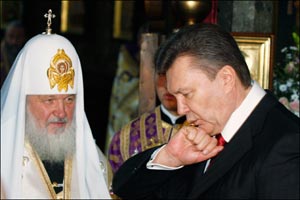 Patriarch Kirill uses Ukraine as his test site. Here we see the key stratagems of his patriarchy. The first one is to make the Moscow Patriarchate one of the most important centers of Russian politics. The patriarch's visit to Ukraine in 2009, which the Moscow Patriarchate never mentions without also using the word “triumphant,” and his Ukrainian politics were to demonstrate to the Kremlin duumvirate and the Russian elite that the patriarch and his available church resources can be more effective in solving serious geopolitical problems than the Russian government. Hence, the Moscow Patriarchate is not a cultural relic and not even a “spiritual authority,” which is dependent on its place in the structure of the government, but its equal partner, whose interests must be respected and considered.
Patriarch Kirill uses Ukraine as his test site. Here we see the key stratagems of his patriarchy. The first one is to make the Moscow Patriarchate one of the most important centers of Russian politics. The patriarch's visit to Ukraine in 2009, which the Moscow Patriarchate never mentions without also using the word “triumphant,” and his Ukrainian politics were to demonstrate to the Kremlin duumvirate and the Russian elite that the patriarch and his available church resources can be more effective in solving serious geopolitical problems than the Russian government. Hence, the Moscow Patriarchate is not a cultural relic and not even a “spiritual authority,” which is dependent on its place in the structure of the government, but its equal partner, whose interests must be respected and considered.
The second stratagem Patriarch Kirill tested in Ukraine in 2009 is the actually “Russian world” doctrine. Its main provision – that is the necessity of creating a supranational project and the ways it will be institutionalized and developed – was published here before the patriarch’s speech at the opening of the third Russian World Assembly on November 3, 2009. It was the reaction to the Russian world in Ukraine that forced the patriarch and his official interpreters to revise not the content – of course – of the doctrine but its rhetoric. Explanations are given that the patriarch’s doctrine is not political but spiritual, and that it does not aim to undermine the sovereignty of nations of the “Russian world” or destroy their cultural individuality.
The third stratagem the patriarch tested in Ukraine was the intention to revise the place of the Russian Church in Orthodoxy. During his visit to Ukraine, the patriarch tests a few theses that argue that not all national Orthodox churches are equal in value, that –unlike the “national” patriarchates – the Moscow Patriarchate is supranational. He even mentions pentarchy as though this ancient church principle has at least some relation to Moscow. This principle of relations among national churches with civilian border has no serious significance. Canonists of the Moscow and St. Petersburg schools – who all their lives taught students the exact opposite – are shocked. They say one of them was advised by an influential person from the patriarch’s entourage to simply rewrite their textbooks.
Then the contours of Ukrainian politics were marked, which included the end of autocephalous aspirations, however perfect they may have be in terms of canon law. Albania can have an autocephalous Orthodox Church because Tirana was never a second Jerusalem. But for us Kyiv was. And as such we will never let it go. The patriarch presented this logic to the stunned public. Further, this is the “End of church homelessness” for the UOC-MP, Proto-deacon A. Kuraev happily announced. The Moscow Patriarchate is working out different ways to destruct the “liberties” of this church, the chief architect of Ukrainian politics – personally the patriarch. Metropolitan Volodymyr strongly impedes the attack. Even moderately pro-Russian bishops have already felt that today a lot less depends on them than was true two years ago.
Finally, the third component of this policy is to refrain from any cooperation or making any compromises with the “schismatics.” Moscow’s rhetoric on this issue is fundamentally different from the one used by Metropolitan Volodymyr. The patriarchate practically openly declared that it is not interested in those Ukrainians who are outside the “savior’s realm,” and – implicitly – is not interested in Ukrainian unity. Interest in the unity of two Russias – the mother and the one that departed – led to the unification of the ROC and ROCOR. For the ROCOR, the right words and appropriate canonical grounds were found; for the UOC-KP, the infamous draft Document on Accepting Schismatics into the Church. Unifying the UOC-MP and the UOC-KP in manner similar to the unification of the ROC and the ROCOR poses a danger for the Moscow Patriarchate: it torpedoes the very possibility for unification.
***
In the Ukrainian church issue there is very little theology and a lot of politics. Only a cynic could argue that the dispute over canonical territory, the title of the head of the Ukrainian Greek Catholic Church, and so on, is theological and not political. This, of course, applies not only to Ukraine and not only to the past decade. When we look at the events in the religious life of our country we often see their political implication. It is not an issue of presidents crossing themselves in church in front of cameras, nor does it have to do with monks and nuns who run for office. It is simply how people construct their society, what they do with the government, how they build relationships with neighbors – all of it greatly depends on what these people believe in. Or not believe in.
The '00s seem to have confirmed rather than refuted this.









